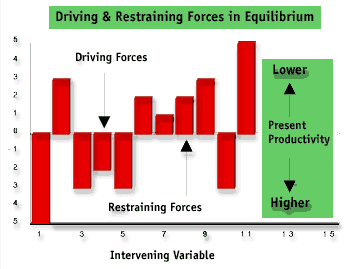 |
| Tratto da: http://www.accel-team.com/index.html | |
|
Force
Field Analysis - Analisi delle Forze in Campo
ConceptForce field analysis is a management technique developed by Kurt Lewin, a pioneer in the field of social sciences, for diagnosing situations. It may be useful when looking at the variables involved in determining effectiveness of and when planning and implementing a change management program and will undoubtedly be of use to you when in your team building efforts. Lewin assumes that in any situation there are both driving and restraining forces that influence any change that may occur. Driving ForcesDriving forces are those forces affecting a situation that are pushing in a particular direction; they tend to initiate a change and keep it going. In terms of improving productivity in a work group, pressure from a supervisor, incentive earnings, and competition may be examples of driving forces. Restraining ForcesRestraining forces are forces acting to restrain or decrease the driving forces. Apathy, hostility, and poor maintenance of equipment may be examples of restraining forces against increased production. Equilibrium is reached when the sum of the driving forces equals the sum of the restraining forces. In our example, equilibrium represents the present level of productivity, as shown in Figure 1. |
|

Figure 1 |
|
EquilibriumThis equilibrium, or present level of productivity, can be raised or lowered by changes in the relationship between the driving and the restraining forces. For illustration, consider the dilemma of the new manager who takes over a work group in which productivity is high but whose predecessor drained the human resources. The former manager had upset the equilibrium by increasing the driving forces (that is, being autocratic and keeping continual pressure on subordinates) and thus achieving increases in output in the short run. By doing this, however, new restraining forces developed, such as increased hostility and antagonism, and at the time of the former manager's departure the restraining forces were beginning to increase and the results manifested themselves in turnover, absenteeism, and other restraining forces, which lowered productivity shortly after the new manager arrived. Now a new equilibrium at a significantly lower productivity is faced by the new manager. Now just assume that our new manager decides not to increase the driving forces but to reduce the restraining forces. The manager may do this by taking time away from the usual production operation and engaging in problem solving and training and development. In the short run, output will tend to be lowered still further. However, if commitment to objectives and technical know-how of the group are increased in the long run, they may become new driving forces, and that, along with the elimination of the hostility and the apathy that were restraining forces, will now tend to move the balance to a higher level of output. Managers are often in a position in which they must consider not only output but also intervening variables and not only short-term but also long-term goals. It can be seen that force field analysis provides framework that is useful in diagnosing these interrelationships. |
|
|
|
|